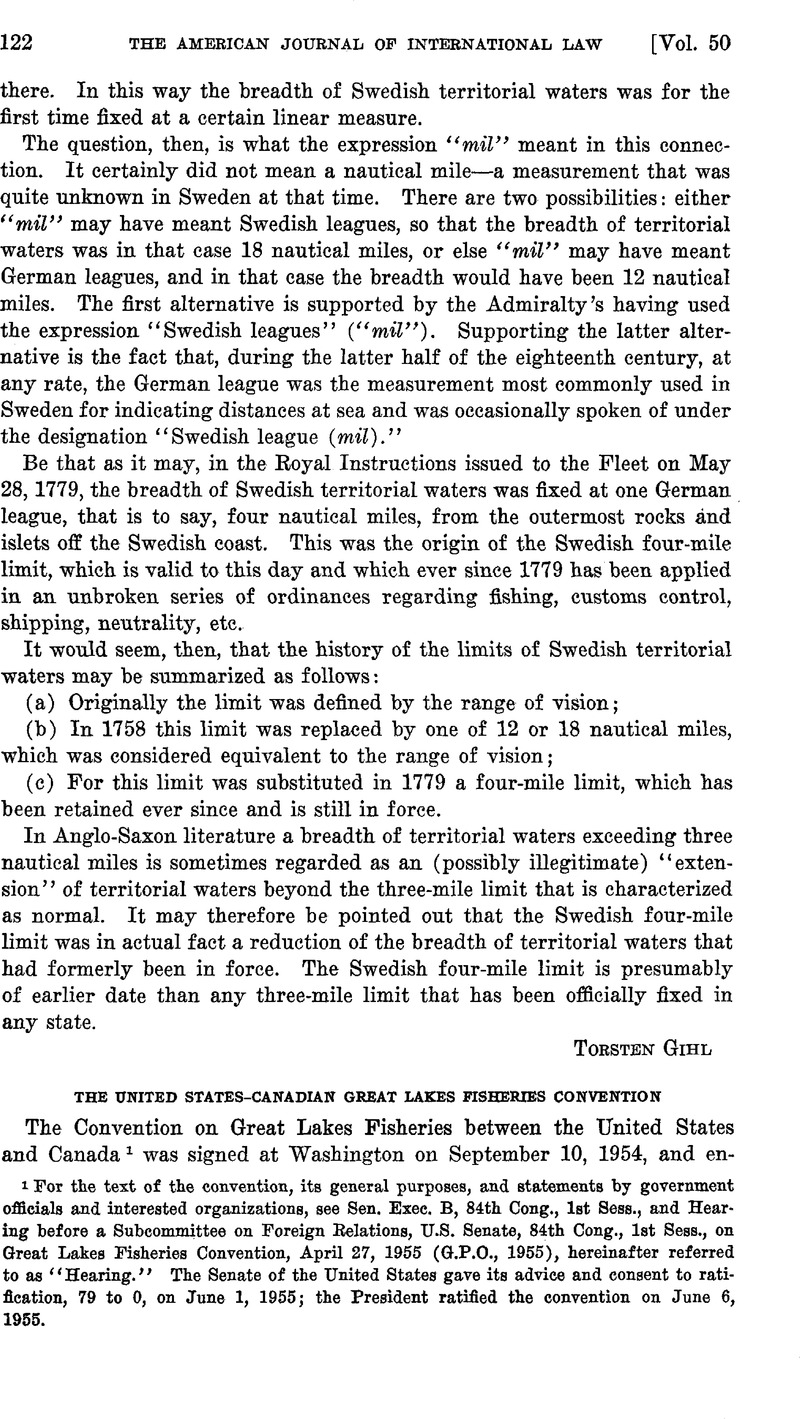No CrossRef data available.
Article contents
The United States-Canadian Great Lakes Fisheries Convention
Published online by Cambridge University Press: 28 March 2017
Abstract

- Type
- Notes and Comments
- Information
- Copyright
- Copyright © American Society of International Law 1956
References
1 For the text of the convention, its general purposes, and statements by government officials and interested organizations, see Sen. Exec. B, 84th Cong., 1st Sess., and Hearing before a Subcommittee on Foreign Relations, U.S. Senate, 84th Cong., 1st Sess., on Great Lakes Fisheries Convention, April 27, 1955 (G.P.O., 1955), hereinafter referred to as “Hearing.” The Senate of the United States gave its advice and consent to ratification, 79 to 0, on June 1, 1955; the President ratified the convention on June 6, 1955.
2 For an excellent discussion of the problems involved in maintaining a fishery at maximum sustained productivity, see W. M. Chapman, “United States Policy on High Seas Fisheries,” 20 Dept. of State Bulletin 67 (1949).
3 See L. Larry Leonard, International Regulation of Fisheries (Wash., D. C, 1944); and A. P. Daggett, “The Regulation of Maritime Fisheries by Treaty,” 28 A.J.I.L. 693 (1934).
4 See article by Paul E. Thompson, Assistant Chief of Fishery Research for the U.S. Fish and Wildlife Service, entitled “Dracula of the Great Lakes,” in Américas (March, 1955), pp. 6–9.
The sea lamprey (Petromyzon marinus) is an eel-like aquatic vertebrate which is widely distributed in temperate and subarctic regions in both fresh and salt waters. It ascends rivers to spawn, and subsists by attaching itself to fishes by the suction-like cup of its mouth, which is equipped with concentric rows of pointed teeth, and using its armored rasping tongue to suck the blood and vital juices of its host.
5 Hunt has pointed out that: “There being no common or unapportioned waters on the Great Lakes and their connecting rivers, and they containing no marginal sea, no part of their waters can be considered as ‘high seas.’ ” Harry E. Hunt, “How the Great Lakes Became ‘High Seas’ and Their Status Viewed from the Standpoint of International Law,” 4 A.J.I.L. 285, 301 (1910). See also 1 Moore’s Digest 670 et seq.
6 See, e.g., The Consolidated Laws of New York, Annotated, Book 10, Art. 4, Sec. 210 et seq. (1951), and Cumulative Annual Pocket Part (1954), for use during 1954–55.
7 16 U.S.C.A. (Conservation), Cumulative Annual Pocket Part (1954), for use during 1955, Ch. 10B, Sec. 777 et seq.
8 Statement by Mr. Warren F. Looney, Acting Special Assistant for Fisheries to the Under Secretary of State, before the Senate Subcommittee, Hearing, p. 10.
9 Ibid., p. 9.
10 See Sen. Exec. B, note 1 supra, p. 2, and Hearing, p. 33.
11 In Lake Huron, the U.S. catch of the lake trout was, in 1935, 1,743,000 pounds; in 1941, it had dropped to 842,000 pounds; in 1951 it was less than 50 pounds. In Lake Michigan, the 1943 catch of lake trout was 6,800,000 pounds; in 1946, 3,974,000 pounds, and in 1952, 3,000 pounds. See Hearing, op. cit. 10.
12 See Thompson, loc. cit. 7, Hearing, op. cit. 10.
13 Ibid. 10, 34.
14 See Thompson, loc. cit., and pictures of two types of barriers at p. 8.
15 See ibid. at 9.
16 Art. I.
17 Art. I.
18 Art. II.
19 Art. II. It is expected that U.S. implementing legislation with respect to the convention will provide that there be a committee for each of the Great Lakes; that each State adjacent to a lake be entitled to appoint 4 members to the advisory committee for that lake; and that these members represent respectively the State conservation agency, the commercial fishing interests, the sport fishing interests, and the public at large. Hearing, p. 12.
20 Art. III.
21 Id.
22 Art. VI.
23 Hearing, p. 12. It is anticipated that the Great Lakes States will participate in the carrying out of the provisions of the programs. The eight States, eaeh with a conservation agency, are expected to play a major rôle, especially in furthering research in the lakes fisheries. Hearing, p. 13.
24 Art. VI.
25 Art. IV.
26 Hearing, p. 11.
27 Art. V.
28 Art. VII.
29 Hearing, p. 12. For text thereof, see 48 A.J.I.L. Supp. 71–81 (1954).
30 Art. VIII. For estimated costs to the United States, see Hearing, p. 13.
31 Art. IX.
32 Art. XI.
33 Art. XIII.
34 Art. XII.
35 Hearing, p. 27. This report, entitled “Organization and Operation of International Fishery Commissions,” was submitted pursuant to a request made by a member of the Senate Foreign Relations Committee on July 21, 1953, at the time of the hearings on the International North Pacific Halibut Convention, that the Department of State be prepared to give an over-all report on our fishery conventions and their organization the next time a fishery convention was submitted for the consideration of the Senate. For text of report, see Hearing, pp. 26–32.




